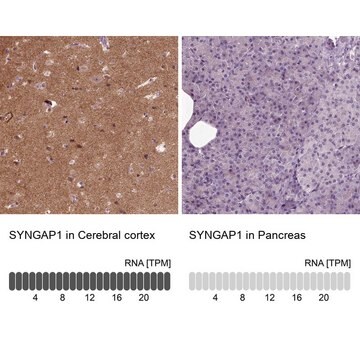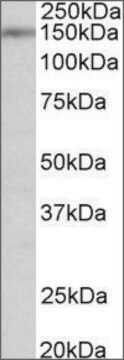All Photos(1)
About This Item
UNSPSC Code:
12352203
eCl@ss:
32160702
NACRES:
NA.41
clone:
polyclonal
application:
ICC
WB
WB
species reactivity:
rat
technique(s):
immunocytochemistry: suitable
western blot: suitable
western blot: suitable
citations:
11
Recommended Products
biological source
rabbit
Quality Level
antibody form
purified antibody
antibody product type
primary antibodies
clone
polyclonal
species reactivity
rat
manufacturer/tradename
Upstate®
technique(s)
immunocytochemistry: suitable
western blot: suitable
NCBI accession no.
UniProt accession no.
shipped in
dry ice
target post-translational modification
unmodified
Gene Information
human ... SYNGAP1(8831)
General description
Silent synapses, or excitatory synapses that lack functional -amino-3-hydroxy-5-methyl-4-isoxazolepropionic acid receptors (AMPARs), are thought to be critical for regulation of neuronal circuits and synaptic plasticity. SynGAP, an excitatory synapse-specific RasGAP, regulates AMPAR trafficking, silent synapse number, and excitatory synaptic transmission in hippocampal and cortical cultured neurons. Over expression of SynGAP in neurons results in a remarkable depression of AMPAR-mediated miniature excitatory postsynaptic currents, a significant reduction in synaptic AMPAR surface expression, and a decrease in the insertion of AMPARs into the plasma membrane. Synaptic transmission is increased in neurons from SynGAP knockout mice as well as in neuronal cultures treated with SynGAP small interfering RNA.
Specificity
SynGAP
Immunogen
peptide (KRLLDAQRGSFPPWVQQTRV) corresponding to amino acids 1289-1308 of rat SynGAP-a
Application
Anti-SynGAP Antibody detects level of SynGAP & has been published & validated for use in IC & WB.
Immunocytochemistry: 0.1 µg/mL has been reported to immunostain SynGAP in neuron cultures fixed with 4% paraformaldehyde, 4% sucrose and perme-abilized with 0.1% Triton X-100 (2).
Research Category
Neuroscience
Neuroscience
Research Sub Category
Synapse & Synaptic Biology
Synapse & Synaptic Biology
Linkage
Replaces: 04-1071
Physical form
Format: Purified
Protein A purified
Purified in PBS with 0.05% NaN3 and 30% Glycerol
Storage and Stability
Maintain at -20°C in undiluted aliquots for up to 1 year after date of receipt.
Legal Information
UPSTATE is a registered trademark of Merck KGaA, Darmstadt, Germany
Disclaimer
Unless otherwise stated in our catalog or other company documentation accompanying the product(s), our products are intended for research use only and are not to be used for any other purpose, which includes but is not limited to, unauthorized commercial uses, in vitro diagnostic uses, ex vivo or in vivo therapeutic uses or any type of consumption or application to humans or animals.
Not finding the right product?
Try our Product Selector Tool.
Storage Class Code
10 - Combustible liquids
WGK
WGK 2
Certificates of Analysis (COA)
Search for Certificates of Analysis (COA) by entering the products Lot/Batch Number. Lot and Batch Numbers can be found on a product’s label following the words ‘Lot’ or ‘Batch’.
Already Own This Product?
Find documentation for the products that you have recently purchased in the Document Library.
Characterization of a novel synGAP isoform, synGAP-beta.
Li, W; Okano, A; Tian, QB; Nakayama, K; Furihata, T; Nawa, H; Suzuki, T
The Journal of Biological Chemistry null
Ayse Dosemeci et al.
FEBS letters, 590(17), 2934-2939 (2016-08-02)
Ankyrin repeat and sterile alpha motif domain-containing protein 1B (ANKS1B, also known as AIDA-1) is a major component of the postsynaptic density (PSD) in excitatory neurons where it concentrates at the electron-dense core under basal conditions and moves out during
SynGAP isoforms exert opposing effects on synaptic strength.
McMahon, AC; Barnett, MW; O'Leary, TS; Stoney, PN; Collins, MO; Papadia, S; Choudhary et al.
Nature Communications null
MET receptor tyrosine kinase controls dendritic complexity, spine morphogenesis, and glutamatergic synapse maturation in the hippocampus.
Qiu, S; Lu, Z; Levitt, P
The Journal of Neuroscience null
Yuko Tanabe et al.
Nature communications, 8(1), 408-408 (2017-09-03)
Coordinated development of excitatory and inhibitory synapses is essential for higher brain function, and impairment in this development is associated with neuropsychiatric disorders. In contrast to the large body of accumulated evidence regarding excitatory synapse development, little is known about
Our team of scientists has experience in all areas of research including Life Science, Material Science, Chemical Synthesis, Chromatography, Analytical and many others.
Contact Technical Service








